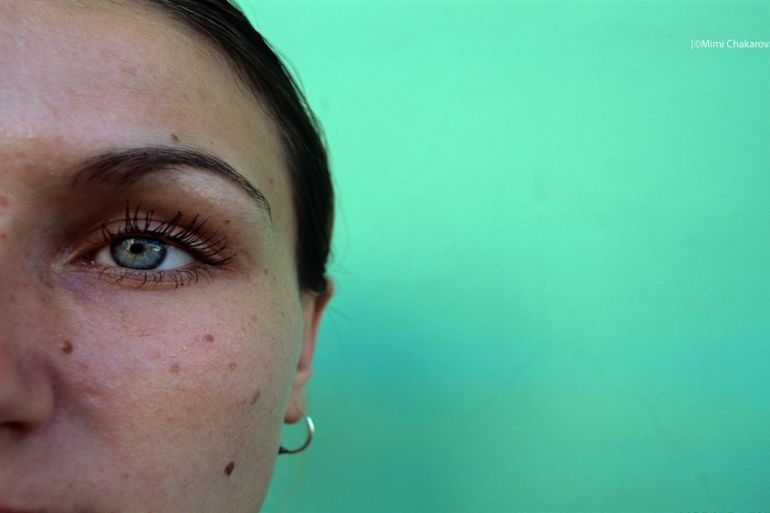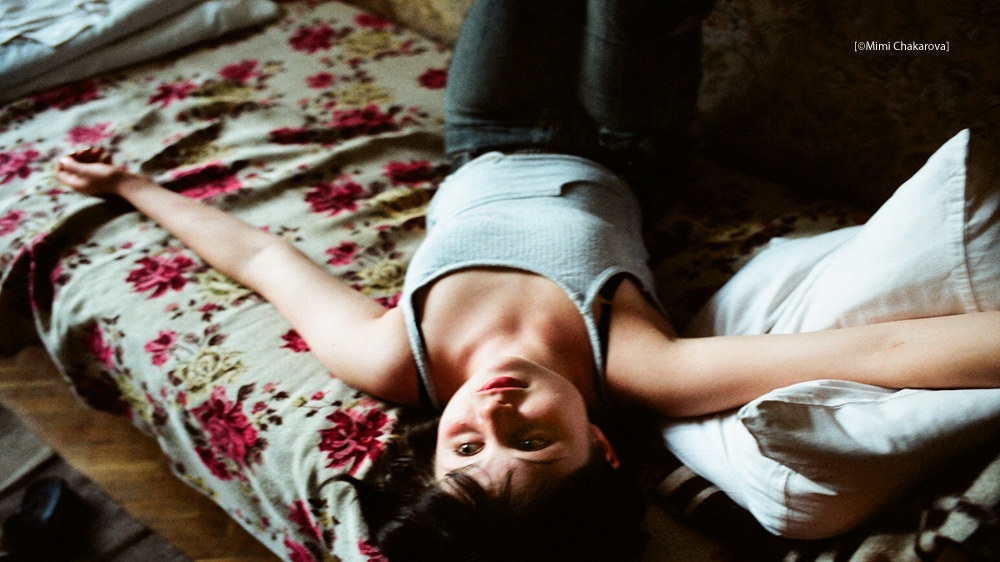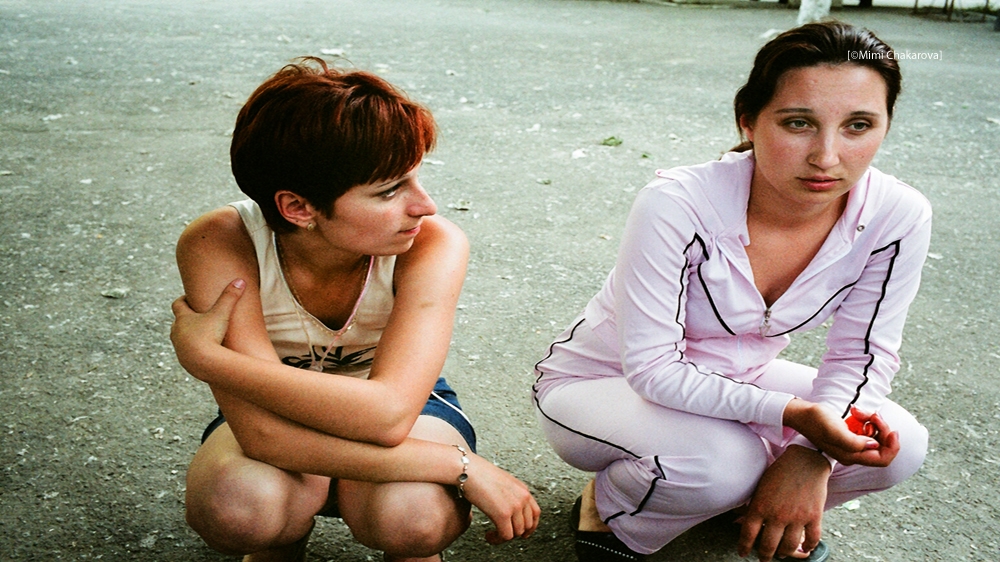Going undercover as a sex worker
A photojournalist describes how she posed as a prostitute to follow the trade in human flesh.

Sometimes I wonder if I would do it again.
That’s the funny thing about life. Experience comes in random, sporadic servings. It’s only years later that the story takes shape.
Keep reading
list of 4 itemsGeorgia’s president vetoes controversial ‘foreign agents’ bill
‘Regime machinery operating efficiently’ as Tunisia cracks down on dissent
Why Egypt backed South Africa’s genocide case against Israel in the ICJ
I didn’t intend to spend more than a year covering human trafficking. It ended up taking a decade. I didn’t intend on reporting in more than two countries. So, how did I end up in nine?
Before my trips, my mum used to ask: “It took us so many years to get out of poverty, why do you keep returning there?” I would sit in her kitchen and the only answer that would come to mind was: “It’s so damn familiar.”
I can say the same about the Balkans. Each time the plane landed, I was home. It could have been Turkey, Greece, Albania, Bulgaria (my birth country), or Macedonia – I wasn’t an outsider. I understood the culture, the rawness of our ways, the dark humour of our days.
But there is one thing I couldn’t understand. What had happened to us? How did we start selling our own girls? How did we make profit from deceit and violence?
At first, I was a photojournalist. I saw the world through the camera. And my idea was to return to my origins and find girls who had survived and escaped their traffickers and pimps.
I knew about the shame and stigma in our culture. I knew that once a girl was forced into prostitution, she could never return and expect her village to understand her ordeal. She was judged, trashed, discarded – even by her own family.
The ‘break down’

It took time to find women who had survived. I went to shelters; I met with lawyers and social workers. And when I finally sat there with one young lady, and took out my camera, I saw an indescribable terror in her eyes.
I assumed that she was afraid of being photographed and recognised by those whom she had escaped. But that was far from the truth.
The camera reminded many of the young women of their experience of being trafficked. They were often photographed by the pimps during what is known as the “break down” period – days or weeks of torture and rape designed to break down the spirit and resistance of their victims. Some were videotaped while being gang-raped.
It was an effective method of control. “If you ever try to run away, we have the photos here as proof. We know where you live. We’ll send them to your father, to your mother,” they were told.
I understood that the camera had become my foe.
It would take time and trust. In some cases it took months, in some years.
I pulled out a notepad instead and listened to their stories. I returned whenever I could. And over time, I started piecing together the reality of sex trafficking. I began to understand what greased its wheels – persistent poverty, demand and corruption.
Showing the faces of these young women was no longer enough of a testament to their courage and strength.
The missing piece of the puzzle was what happened to the women once they were sold in the countries that exploited them as sex slaves.
I decided to follow their route, making my way to the red-light districts and brothels of Istanbul, Athens, Dubai, Prague …
‘The banality of evil’

|
|
It was dangerous. But there was another problem. As a woman, I couldn’t pose as a client as many of my male investigative colleagues did.
I also had no budget for this work so coming up with a more elaborate undercover trafficking operation wasn’t a viable option. I had to become one of the women. I had to devise a plan that could get me into these spaces. And I had to bring in hidden cameras and film what I was seeing.
The banality of evil helps its disguise.
Imagine this: an apartment in a regular neighbourhood in Istanbul with a fruit stand nearby. In it lives a husband, his wife and their two children. They have an extra room that is always locked.
Men ring the doorbell during the day. It gets very busy around lunchtime. The husband unlocks the door to the room, stands outside, then escorts the men to the front door when they’re finished, collects their money and tells them to come again.
All the while, the wife and children go about their daily routine of homework, dish-washing and soap-opera watching.
Inside the room are three trafficked girls from Moldova. There are dirty blankets on the floor. They sleep on those. The window is barred and locked. The girls wear T-shirts and panties. They haven’t showered for days.
The customer enters the room, chooses the girl he wants and forces himself on her. He pays by the minute.
The other two huddle in the corner and wait for it to be over. They often face the wall, but they no longer cry.
One of them has been looking for a sharp object with which to slit her wrists but finds nothing in the room.
She will have to steal something from a client. She hopes for a knife, but wonders how she will get it from his pocket.
Once a day, the door opens and the man – the father of the children and husband of the wife – throws a few bananas into the room, then quickly locks the door. They are nothing but filthy animals, he thinks to himself.
‘It eats at your dreams’

|
|
After we released the resulting documentary, The Price of Sex, I travelled with the film for two years and spoke to people all over the world. At the end of those two years, I counted how many cities and venues I had spoken at – 67.
The questions that came up were often similar: How has this work changed you?; Don’t you think that men are the reason this continues to exist?; What’s the solution? Do you think making a film about something so complex is enough?
Yes, this work has changed me. I’ve seen some of the worst that we are capable of. I’ve been in the presence of sadness that has no end.
It’s a well without a bottom full of water as black as the darkest night.
It’s a place you can’t return from unharmed.
Once you enter this world, it consumes you and eats at your dreams. The images are most vivid at night.
But no, men are not the only reason why trafficking continues to happen all over our world. Women stand by and watch.
Women sell women. Women deceive women.
Anyone who oversimplifies how the system operates is doing a disservice to the many moving parts of this perfectly designed machine. It runs on profit.
It has nothing to do with human life. In fact, that’s not even a discussion of concern.
All you have to do is spend enough time around traffickers and pimps to know how they perceive the women they sell.
They are cattle, cargo, a commodity to be used and resold as many times as possible.
If she starts acting up, if she gets sick, if she takes too long to complete the tasks she has been ordered to do, you beat or kill her, dump her in the sea, burry her in the backyard or toss her from a highrise. And you get another one in her place.
If she cuts herself too many times, you sell her to another brothel where they like scarred girls.
There is a market for everything. Pregnant? Even better. In Dubai, you can double the price. There are clients looking for pregnant girls.
There are clients looking for girls who are locked and forced into a life of prostitution. I know this because I’ve seen it with my own eyes.
A girl unbuttons her shirt and tells me: “Take a picture.” Her chest is covered with cigarette burns.
“They used me as an ashtray,” she says.
I can’t take the picture. I tell her to button her shirt. We sit in silence.
‘My only weapon is my work’

I was given an award for courage at the Lincoln Center in New York. I said they should have given me an award for anger instead. There is nothing courageous about what I’ve done.
In fact, let me be honest. I never wanted to get on a plane. I was always scared.
I would wait until the last moment to pack. I would think of a million reasons to cancel or postpone a trip.
It’s not courage that got me to the airport. It’s the fact that I had promised to return and I had to keep that promise or everyone I had involved over the years would think I didn’t care or that I had given up on them.
I had become a part of the lives of too many people.
I couldn’t let down all the girls who had talked to me and eventually let me film them.
My only weapon is my work. My only way of seeking justice is through my reporting and filming. Everything I knew about trafficking went into the making of The Price of Sex .
But is one film enough to make a change?
Well, it’s a start.
The Price of Sex was used as a tool in anti-corruption police units in Serbia before we even released it.
Then several months later, the US State Department asked to use it as a training tool in embassies throughout the world.
Then I was invited by the United Nations Office on Drugs and Crime to discuss anti-corruption practices.
And after almost three years of this documentary being shown at film festivals, universities and on television screens throughout the world, I was finally able to get it in front of viewers in Turkey.
CNN Turk reached out and conducted an interview with me about my undercover work in Istanbul.
Turkey’s largest daily paper also published a full spread on the film and the women trafficked and sold into prostitution in Istanbul.
READ MORE: Stories from the sex trade
Offering alternatives
![A girl worries about the fate of her sister, who left for Turkey three years prior to this photo being taken. The family had only heard from her once – a letter she sent to her home village. Her parents didn't know whether she was still alive. I travelled to Turkey and was able to find her. She had been trafficked for sex in Istanbul, but a client helped her escape. He married her, and they have a child together. She called her parents the day I found her to tell them she is alive but can't return home because the pimps kept her passport. She remains in Turkey as an illegal immigrant, and rarely leaves the house out of fear of being deported and losing custody of her son - Moldova, 2004 [Mimi Chakarova]](/wp-content/uploads/2015/06/508a9d44d4464d1798e0f44f75dc3961_18.jpeg)
People don’t know.
Those of us who work in journalism assume that everyone has the information necessary to make the right decisions. But they don’t.
The perfect example of this was the number of sold-out screenings I was personally present for.
I couldn’t believe it when I would see hundreds of people waiting in line on a Friday or Saturday night to watch a documentary film about trafficking.
Wouldn’t they rather watch a comedy, I’d wonder. The film is 73 minutes long. So why did people stay for an additional two hours of Q&A? Because they want answers.
READ MORE: Inside Sonagachi, Asia’s largest red-light district
It is our job to connect the dots and to spend time investigating complex and dangerous issues. It is also our job to offer realistic solutions.
I know many of my colleagues would disagree with me on that last statement. But making the film was not enough. I had to ensure that I offered the knowledge I had gathered from the people who shared it with me over the years.
I also had personal insight into the way trafficking works in many different countries. And unless we address corruption in the police units and the judicial branches in the countries that benefit from trafficked flesh, unless we offer alternatives for those living in some of the poorest nations in this world, we will continue to see steady numbers of desperate young girls being sold into one of the darkest and most brutal industries of our time.
Education and awareness are not enough. What is required is unilateral action across borders.
‘Would I do it again?’

Sometimes I wonder if I would do it again. Would I risk my life knowing everything I know now? Would I pose as a prostitute? Would I enter these brothels again with the hope of finding a way out, and not show fear?
I would if I knew that the outcome would be as powerful as it has been.
Millions have seen the film. Minds have been changed. Young people have a tool they can use and learn from for years to come.
But here is the crazy part. Even if only 20 people got to see the film, I would still do it again. I couldn’t let down all the girls who trusted me to take their stories and to do something good with them. I couldn’t let them down.
For the past decade, photographer and filmmaker Mimi Chakarova has covered global issues examining conflict, corruption and the sex trade. Her film The Price of Sex , a feature-length documentary on trafficking and corruption premiered in 2011.
Chakarova has won numerous awards including the Nestor Almendros Award for courage in filmmaking, the prestigious Daniel Pearl Award for Outstanding International Investigative Reporting, the Magnum Photos Inge Morath Award for her work on sex trafficking, and a People’s Voice Webby as well as a nomination for a News & Documentary Emmy Award. She is also the recipient of the Dorothea Lange Fellowship for outstanding work in documentary photography.
This article first appeared in the Al Jazeera Magazine.